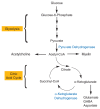The role of thiamine deficiency in alcoholic brain disease
- PMID: 15303623
- PMCID: PMC6668887
The role of thiamine deficiency in alcoholic brain disease
Abstract
A deficiency in the essential nutrient thiamine resulting from chronic alcohol consumption is one factor underlying alcohol-induced brain damage. Thiamine is a helper molecule (i.e., a cofactor) required by three enzymes involved in two pathways of carbohydrate metabolism. Because intermediate products of these pathways are needed for the generation of other essential molecules in the cells (e.g., building blocks of proteins and DNA as well as brain chemicals), a reduction in thiamine can interfere with numerous cellular functions, leading to serious brain disorders, including Wernicke-Korsakoff syndrome, which is found predominantly in alcoholics. Chronic alcohol consumption can result in thiamine deficiency by causing inadequate nutritional thiamine intake, decreased absorption of thiamine from the gastrointestinal tract, and impaired thiamine utilization in the cells. People differ in their susceptibility to thiamine deficiency, however, and different brain regions also may be more or less sensitive to this condition.
Figures



References
-
- Ambrose ML, Bowden SC, Whelan G. Thiamin treatment and working memory function of alcohol-dependent people: Preliminary findings. Alcoholism: Clinical and Experimental Research. 2001;25(1):112–116. - PubMed
-
- Baker KG, Harding AJ, Halliday GM, et al. Neuronal loss in functional zones of the cerebellum of chronic alcoholics with and without Wernicke’s encephalopathy. Neuroscience. 1999;91:429–438. - PubMed
-
- Blass JP, Gibson GE. Abnormality of a thiamine-requiring enzyme in patients with Wernicke-Korsakoff syndrome. New England Journal of Medicine. 1977;297:1367–1370. - PubMed
-
- Calingasan NY, Chun WJ, Park LC, et al. Oxidative stress is associated with region-specific cell death during thiamine deficiency. Journal of Neuropathology and Experimental Neurology. 1999;58(9):946–958. - PubMed
-
- Charness ME. Brain lesions in alcoholics. Alcoholism: Clinical and Experimental Research. 1993;17:2–11. - PubMed
Publication types
MeSH terms
Substances
LinkOut - more resources
Full Text Sources
